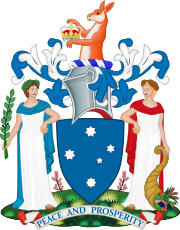Government of Victoria
 Logo of the Victorian Government and its agencies | |
 Coat of arms of the State of Victoria, used for formal and ceremonial purposes. | |
| Formation |
|
|---|---|
| Australian state | Victoria |
| Website | http://www.vic.gov.au/ |
| Legislative branch | |
| Legislature | Parliament of Victoria;
|
| Meeting place | Parliament House |
| Executive branch | |
| Main organ | Victorian Ministry |
| Leader | Premier |
| Appointer | Governor |
| Meeting place | Parliament House |
| Judicial branch | |
| Court | Supreme Court |
| Seat | Melbourne |
The Government of Victoria is the executive administrative authority of the Australian state of Victoria.
Functioning within the scope of Victoria's status as a sub-national parliamentary constitutional monarchy, the Government was first formed in 1851, when Victoria first gained the right to responsible government. Since the Federation of Australia in 1901, Victoria has been a state of the Commonwealth of Australia, and the Constitution of Australia regulates its relationship with the Commonwealth. Under the Australian Constitution, Victoria ceded legislative and judicial supremacy to the Commonwealth, but retained powers in all matters not in conflict with the Commonwealth.
The Victorian Government enforces Acts passed by the state Parliament through its vast array of government departments, statutory authorities and other related agencies. The Government is formally presided by the Governor of Victoria, who exercises their executive authority granted by the Constitution through the Executive Council, a body consisting of senior cabinet ministers. In reality, both the Governor and the Council are mostly ceremonial, with the Premier and their ministers having the real power over policy decisions, appointments and other executive orders made by the Governor-in-Council.
The current Premier is Daniel Andrews, a member of the Labor Party, while Linda Dessau has served as the Governor since 2015.
Contents
1 Executive power
2 Legislative power
3 Judicial power
4 See also
5 References
6 External links
Executive power
The Government of Victoria operates under the principles of the Westminster system, a form of parliamentary government based on the model of the United Kingdom.
Executive power rests formally with the Executive Council, which consists of the Governor and senior ministers. In practice, executive power is exercised by the Premier of Victoria, who is appointed by the Governor and who hold office by virtue of his or her ability to command the support of a majority of members of the Legislative Assembly, and the Cabinet designated by the Premier to the Governor. The Cabinet is the government's chief policy-making organ, and consists of the Premier and all ministers.
Legislative power
Legislative power rests with the Parliament of Victoria, which consists of Elizabeth II, Queen of Australia, represented by the Governor of Victoria, and the two Houses, the Victorian Legislative Council (the upper house) and the Victorian Legislative Assembly (the lower house).
Judicial power
Judicial power is exercised by the Supreme Court of Victoria and a system of subordinate courts, but the High Court of Australia and other federal courts have overriding jurisdiction on matters which fall under the ambit of the Australian Constitution.
See also
@media all and (max-width:720px){.mw-parser-output .mobile-float-reset{float:none!important;width:100%!important}}.mw-parser-output .stack-container{box-sizing:border-box}.mw-parser-output .stack-clear-left{float:left;clear:left}.mw-parser-output .stack-clear-right{float:right;clear:right}.mw-parser-output .stack-left{float:left}.mw-parser-output .stack-right{float:right}.mw-parser-output .stack-object{margin:1px;overflow:hidden}
- Victorian Ministry
- List of Victorian government agencies
- Local government areas of Victoria
Victorian Charter of Human Rights and Responsibilities (2006)
References
External links
- Government of Victoria website
- Tourism Victoria

